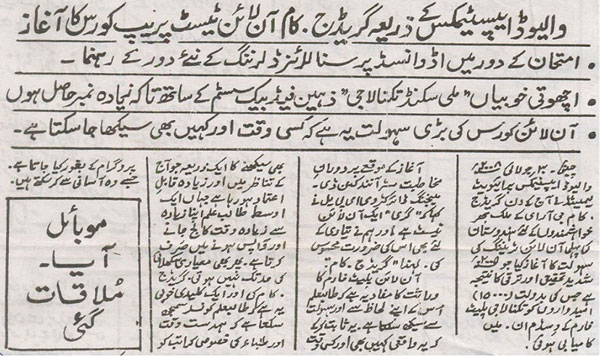Handwritten Newspaper
Chennai’s The Musalman is the last handwritten newspaper in the world.
Because it looks like a curious remnant, The Musalman attracts curiosity. It is, they say, the oldest Urdu daily, and perhaps the only newspaper in the world still written by hand. Just as the recent announcement by Godrej & Boyce, the last big manufacturer of manual typewriters, that it would stop making the machines drew worldwide media, so The Musalman has drawn media interest since 2007.
This has been a significant period for the paper — not because it has changed but because, despite computerization in the industry and a change of leadership, it has not. On April 26, 2008, owner-editor Syed Fazlullah died, leaving the paper in the hands of his sons. His youngest son, Syed Arifullah, now runs the paper. His paper is still written out by hand, still produced in the same 800 sq ft office near Wallajah Mosque in Chennai’s Triplicane, still sells 21,000 copies a day (according to Registrar of Newspapers for India), and still makes very little money.
«It is in balance only for the past three years», says Arifullah quietly over the phone. What keeps the paper running is the compact between the few employees — including the three long-time katibs or calligraphers Khurshid Begum, Shabana Begum, and Rehman Hussain — and its readers.
Urdu is both a limit and a safeguard. «It’s a little bit difficult», says Arifullah, «because Urdu in Chennai is not a common language». But it also gives the paper a monopoly over Urdu readers.
Why Urdu? The decision was taken by Arifullah’s grandfather Syed Azmathullah when he founded the paper in 1927. «There was no voice of Muslims in the south,» Arifullah explains, at that time. Indeed, in 1927 the paper was inaugurated by Mukhtar Ahmed Ansari, president of that year’s Congress session. Much later, Indira Gandhi as PM is said to have remarked during a press conference that The Musalman with its Hindu reporter and The Hindu with its Muslim reporter together provided a picture of secularism in India. The Musalman’s chief reporter is still Hindu.
Making The Musalman is simple but laborious. It is a broadsheet folded to make four pages. The front page has local and national news. Page two has international news and editorials. Page three contains Hadith, quotes from the Qur’an and (incongruously) sports. The last page has «everything», says Arifullah, with a focus on local news. There are ads from local businesses, «exhibitions, circus, new products», and even Aligarh Muslim University.
News comes in from part-time reporters in different cities, once by fax, now also email. «We are not able to afford» full-time Urdu reporters, the editor says, so the material often comes in English. Three translators turn it into Urdu. The katibs then write the copy out on paper with quills and ink, three hours per page, and paste all the items on a form. If a mistake is made or a news update arrives, the page is rewritten. The form is turned into a negative, which is used to make the plate for printing.
All Urdu newspapers were handwritten until 1996, says Rajeev Jha of Gurgaon-based Concept Software. InPage, Concept’s software, is used by Urdu computer users around the world to type in the Nastaliq style, with each word a cascade of joined letters, and read files on different computers. Managing the «ligatures» or connections is what held up Urdu computer use, and helped sustain the katibs. Now it is possible to switch (InPage costs Rs 17,500 or $350) but, as Arifullah says, «The heart of The Musalman is calligraphy». Calligraphy is easier to read, he says. «If you write it in hand the font size will be big, the words will be clear.» It is also more beautiful. His readers prefer it.
On May 11, the Ministry of External Affairs’ Public Diplomacy Division released on YouTube an 11-minute film on The Musalman, directed by Ishani K Dutta of Delhi-based Carrot Films. Dutta hopes that when the film is shown in Arab countries and Europe it will generate support. «It’s just passion that is driving them. The katibs really don’t get a lot of money, but they actually enjoy this whole process».
She adds that, partly because of the texts on page three, «They don’t want to sell as others do». The paper should not end up as raddi. «So they only take subscribers». Arifullah says that they do have some street sales in Chennai.
The list of the Registrar of Newspapers for India shows dozens of Urdu periodicals. In this list, sales of 21,000 put The Musalman far from the bottom. At Rs 1 per copy, including 25 paisa for mailing, its subscribers are not burdened. The future, if not good, at least looks survivable.
Source: Business Standard
Preservation of a Dream
Calligraphy is the art of both ideal writing and an ideal soul.




